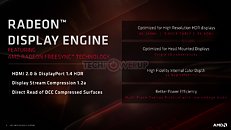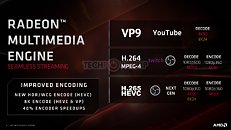- Joined
- Oct 9, 2007
- Messages
- 47,670 (7.43/day)
- Location
- Dublin, Ireland
| System Name | RBMK-1000 |
|---|---|
| Processor | AMD Ryzen 7 5700G |
| Motherboard | Gigabyte B550 AORUS Elite V2 |
| Cooling | DeepCool Gammax L240 V2 |
| Memory | 2x 16GB DDR4-3200 |
| Video Card(s) | Galax RTX 4070 Ti EX |
| Storage | Samsung 990 1TB |
| Display(s) | BenQ 1440p 60 Hz 27-inch |
| Case | Corsair Carbide 100R |
| Audio Device(s) | ASUS SupremeFX S1220A |
| Power Supply | Cooler Master MWE Gold 650W |
| Mouse | ASUS ROG Strix Impact |
| Keyboard | Gamdias Hermes E2 |
| Software | Windows 11 Pro |
Two of the often overlooked components of a new graphics architecture are the I/O and multimedia capabilities. With its Radeon RX 5700-series "Navi 10" graphics processor, AMD gave the two their first major update in over two years, with the new Radeon Display Engine, and Radeon Multimedia Engine. The Display Engine is a hardware component that handles the graphics card's physical display I/O. The Radeon Multimedia Engine is a set of fixed-function hardware that provides CODEC-specific acceleration to offload your CPU.
The Navi Radeon Display Engine features an updated DisplayPort 1.4 HDR implementation that's capable of handling 8K displays at 60 Hz with a single cable. It can also handle 4K UHD at 240 Hz with a single cable. These also include HDR and 10-bit color. It achieves this by implementing DSC 1.2a (Display Stream Compression). The display controller also supports 30 bpp internal color-depth. The HDMI implementation remains HDMI 2.0. The multi-plane overlay protocol (MPO) implementation now supports a low-power mode. This should, in theory, reduce the GPU's power draw when idling or playing back video.


The Radeon Multimedia Engine is updated with support for more CODECs. The "Navi 10" GPU provides hardware-acceleration for decoding VP9 video at formats of up to 4K @ 90 fps (frames per second), or 8K @ 24 fps. The H.265 HEVC implementation is more substantial, with hardware-accelerated encoding of 4K at frame-rates of up to 60 fps. H.265 HEVC decoding is accelerated at 8K @ 24 fps, and 4K @ 90 fps, and 1080p at up to 360 fps. H.264 MPEG4 encoding gets a boost of 4K @ 150 fps, and 1080p @ 600 fps decoding; and 4K @ 90 fps and 1080p @ 150 fps encoding.
View at TechPowerUp Main Site
The Navi Radeon Display Engine features an updated DisplayPort 1.4 HDR implementation that's capable of handling 8K displays at 60 Hz with a single cable. It can also handle 4K UHD at 240 Hz with a single cable. These also include HDR and 10-bit color. It achieves this by implementing DSC 1.2a (Display Stream Compression). The display controller also supports 30 bpp internal color-depth. The HDMI implementation remains HDMI 2.0. The multi-plane overlay protocol (MPO) implementation now supports a low-power mode. This should, in theory, reduce the GPU's power draw when idling or playing back video.


The Radeon Multimedia Engine is updated with support for more CODECs. The "Navi 10" GPU provides hardware-acceleration for decoding VP9 video at formats of up to 4K @ 90 fps (frames per second), or 8K @ 24 fps. The H.265 HEVC implementation is more substantial, with hardware-accelerated encoding of 4K at frame-rates of up to 60 fps. H.265 HEVC decoding is accelerated at 8K @ 24 fps, and 4K @ 90 fps, and 1080p at up to 360 fps. H.264 MPEG4 encoding gets a boost of 4K @ 150 fps, and 1080p @ 600 fps decoding; and 4K @ 90 fps and 1080p @ 150 fps encoding.
View at TechPowerUp Main Site






